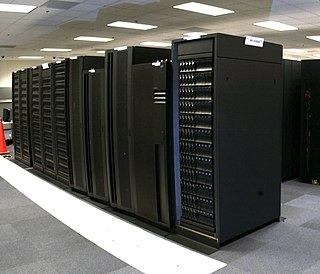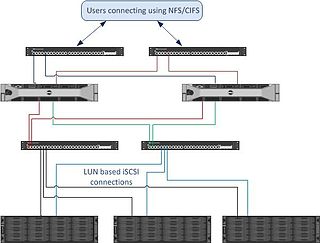
A hard disk drive (HDD), hard disk, hard drive, or fixed disk, is an electro-mechanical data storage device that stores and retrieves digital data using magnetic storage with one or more rigid rapidly rotating platters coated with magnetic material. The platters are paired with magnetic heads, usually arranged on a moving actuator arm, which read and write data to the platter surfaces. Data is accessed in a random-access manner, meaning that individual blocks of data can be stored and retrieved in any order. HDDs are a type of non-volatile storage, retaining stored data when powered off. Modern HDDs are typically in the form of a small rectangular box.

Small Computer System Interface is a set of standards for physically connecting and transferring data between computers and peripheral devices. The SCSI standards define commands, protocols, electrical, optical and logical interfaces. The SCSI standard defines command sets for specific peripheral device types; the presence of "unknown" as one of these types means that in theory it can be used as an interface to almost any device, but the standard is highly pragmatic and addressed toward commercial requirements. The initial Parallel SCSI was most commonly used for hard disk drives and tape drives, but it can connect a wide range of other devices, including scanners and CD drives, although not all controllers can handle all devices.

Western Digital Corporation is an American computer drive manufacturer and data storage company, headquartered in San Jose, California. It designs, manufactures and sells data technology products, including data storage devices, data center systems and cloud storage services.

In computer hardware, a host controller, host adapter, or host bus adapter (HBA), connects a computer system bus, which acts as the host system, to other network and storage devices. The terms are primarily used to refer to devices for connecting SCSI, SAS, Fibre Channel and SATA devices. Devices for connecting to FireWire, USB and other devices may also be called host controllers or host adapters.

Clariion is a discontinued SAN disk array manufactured and sold by EMC Corporation, it occupied the entry-level and mid-range of EMC's SAN disk array products. In 2011, EMC introduced the EMC VNX Series, designed to replace both the Clariion and Celerra products.
NetApp, Inc. is an American data storage and data management services company headquartered in San Jose, California. It has ranked in the Fortune 500 from 2012 to 2021. Founded in 1992 with an initial public offering in 1995, NetApp offers cloud data services for management of applications and data both online and physically.
The HP Storageworks XP is a computer data storage disk array sold by Hewlett Packard Enterprise using Hitachi Data Systems hardware and adding their own software to it. It's based on the Hitachi Virtual Storage Platform and targeted towards enabling large scale consolidation, large database, Oracle, SAP, Exchange, and online transaction processing (OLTP) environments.
A NetApp FAS is a computer storage product by NetApp running the ONTAP operating system; the terms ONTAP, AFF, ASA, FAS are often used as synonyms. "Filer" is also used as a synonym although this is not an official name. There are three types of FAS systems: Hybrid, All-Flash, and All SAN Array:
- NetApp proprietary custom-build hardware appliances with HDD or SSD drives called hybrid Fabric-Attached Storage
- NetApp proprietary custom-build hardware appliances with only SSD drives and optimized ONTAP for low latency called ALL-Flash FAS
- All SAN Array build on top of AFF platform, and provide only SAN-based data protocol connectivity.
The IBM SAN Volume Controller (SVC) is a block storage virtualization appliance that belongs to the IBM System Storage product family. SVC implements an indirection, or "virtualization", layer in a Fibre Channel storage area network (SAN).

The IBM BladeCenter was IBM's blade server architecture, until it was replaced by Flex System in 2012. The x86 division was later sold to Lenovo in 2014.

A solid-state drive (SSD) is a solid-state storage device that uses integrated circuit assemblies to store data persistently, typically using flash memory, and functioning as secondary storage in the hierarchy of computer storage. It is also sometimes called a semiconductor storage device, a solid-state device or a solid-state disk, even though SSDs lack the physical spinning disks and movable read–write heads used in hard disk drives (HDDs) and floppy disks. SSD also has rich internal parallelism for data processing.

The IBM Storage product portfolio includes disk, flash, tape, NAS storage products, storage software and services. IBM's approach is to focus on data management.

Universal Storage Platform (USP) was the brand name for an Hitachi Data Systems line of computer data storage disk arrays circa 2004 to 2010.
Virtual Storage Platform is the brand name for a Hitachi Data Systems line of computer data storage systems for data centers. Model numbers include G200, G400, G600, G800, G1000, G1500 and G5500
Adaptable Modular Storage 2000 is the brand name of Hitachi Data Systems mid-range storage platforms.

The Dell blade server products are built around their M1000e enclosure that can hold their server blades, an embedded EqualLogic iSCSI storage area network and I/O modules including Ethernet, Fibre Channel and InfiniBand switches.

Dell Fluid File System, or FluidFS, is a shared-disk filesystem made by Dell that provides distributed file systems to clients. Customers buy an appliance: a combination of purpose-built network-attached storage (NAS) controllers with integrated primary and backup power supplies attached to block level storage via the iSCSI or Fiber Channel protocol. A single Dell FluidFS appliance consists of two controllers operating in concert connecting to the back-end storage area network (SAN). Depending on the storage capacity requirements and user preference, FluidFS version 4 NAS appliances can be used with Compellent or EqualLogic SAN arrays. The EqualLogic FS7600 and FS7610 connect to the client network and to Dell's EqualLogic arrays with either 1 Gbit/s (FS7600) or 10 Gbit/s (FS7610) iSCSI protocol. For Compellent, FluidFS is available with either 1 Gbit/s or 10 Gbit/s iSCSI connectivity to the client network and connection to the backend Compellent SAN can be either 8 Gbit/s Fibre Channel or 10 Gbit/s iSCSI.

IBM FlashSystem is an IBM Storage enterprise system that stores data on flash memory. Unlike storage systems that use standard solid-state drives, IBM FlashSystem products incorporate custom hardware based on technology from the 2012 IBM acquisition of Texas Memory Systems.

The IBM DS8000 series is an IBM storage media platform with hybrid flash and hard disk storage for IBM mainframes and other enterprise grade computing environments.
IBM FlashCore Modules (FCM) are solid state technology computer data storage modules using PCI Express attachment and the NVMe command set. The raw storage capacities are 4.8 TB, 9.6 TB, 19.2 TB and 38.4 TB. The FlashCore modules support hardware self-encryption and real-time inline hardware data compression without performance impact. They are used in selected arrays from the IBM FlashSystem family.














